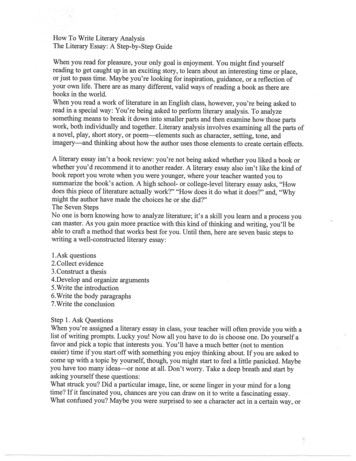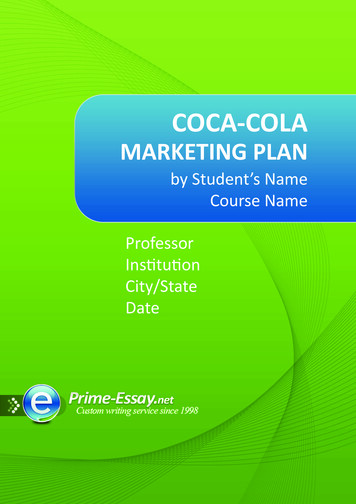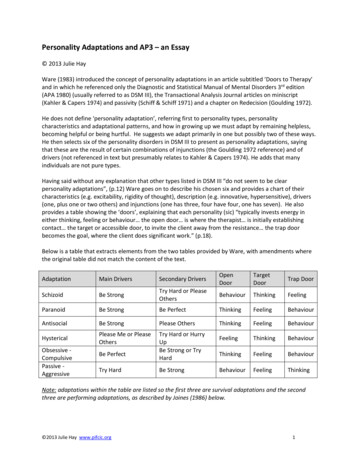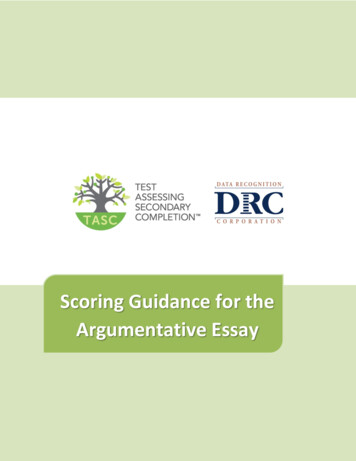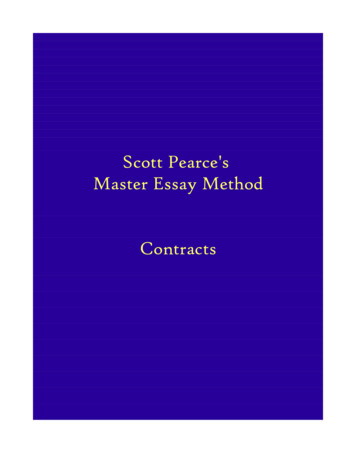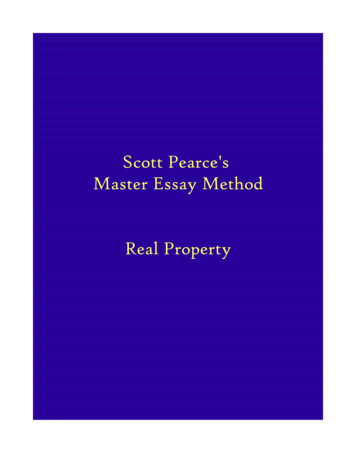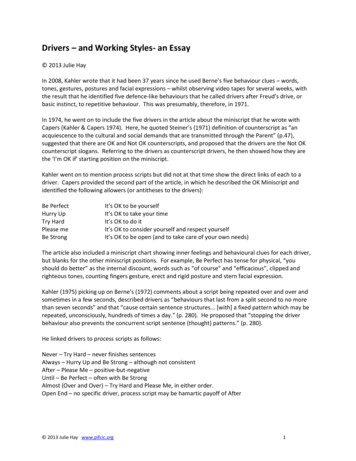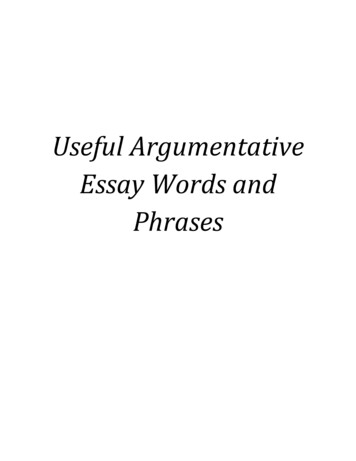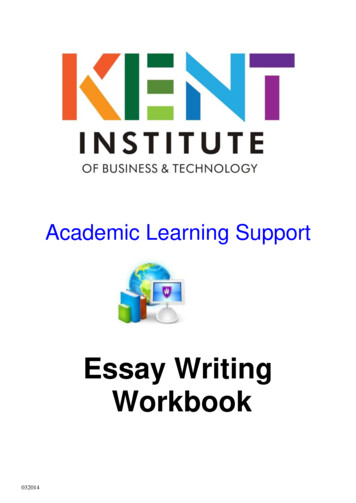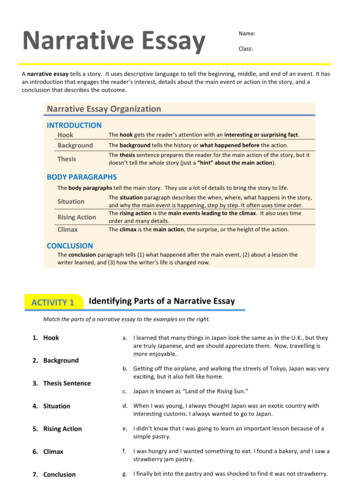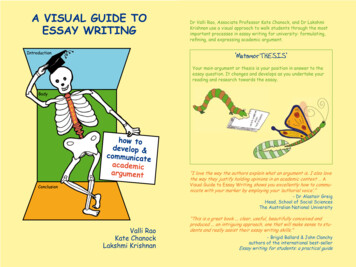
Transcription
A VISUAL GUIDE TOESSAY WRITINGDr Valli Rao, Associate Professor Kate Chanock, and Dr LakshmiKrishnan use a visual approach to walk students through the mostimportant processes in essay writing for university: formulating,refining, and expressing academic argument.‘MetamorTHESIS‘Your main argument or thesis is your position in answer to theessay question. It changes and develops as you undertake yourreading and research towards the essay.how todevelop &communicateacademicargument“I love the way the authors explain what an argument is. I also lovethe way they justify holding opinions in an academic context AVisual Guide to Essay Writing shows you excellently how to communicate with your marker by employing your ‘authorial voice’.”- Dr Alastair GreigHead, School of Social SciencesThe Australian National UniversityValli RaoKate ChanockLakshmi Krishnan“This is a great book . clear, useful, beautifully conceived andproduced . an intriguing approach, one that will make sense to students and really assist their essay writing skills.”- Brigid Ballard & John Clanchyauthors of the international best-sellerEssay writing for students: a practical guide
How effective structure supports reasoned argument in essays1Discipline/fieldTopicUnderlying questionIntroduce discipline/field/context and topicRoughly,10–15%of essaylengthWhy is this topic interesting from the perspective of the discipline/field?[also consider how interested you are in the topic]INTRODUCTIONFocusAs necessary, indicate relevant debate, previous research,problem, definitions, scope in time & place, etcSignpost structure of argumentTell the reader the sequence of your sections/issues in the body of your essayIndicate thesis statement(your main line of argument)Indicate your answer to theunderlying raphsparagraphSection:1st issueRoughly,80% ofessaylengthSection:2nd phBODYSection:3rd issueparagraphparagraphRoughly,5–10%of raph structure1 paragraph 1 main idea 100/150/200 wordsTopic sentence(the main idea in theparagraph; feeds intosection/issue)Analyse/evaluateSupporting sentences(evidence, eDraw together your findings/analysis fromeach section of your argumentState your conclusion/evaluation/researchedthesis, based on your findingsConsider the implications of your evaluationfor the debate/problem in your discipline/field1Read the assessment task carefully because a topic or discipline often requires adifferent structure. And always remember the golden ‘creativity rule’ — all rules aremeant to be broken, it’s just that you first need to know them!
Valli Rao’s doctorate, in Englishliterature, compared biblicalarchetypes in the works ofWilliam Blake and BernardShaw. She has researched inthe British Library, taughtliterature at Flinders andAdelaide Universities, and hastwo daughters. She is now anadviser with the AcademicSkills & Learning Centre at theAustralian National University.Valli enjoys theatre, birdwatching and yoga. Her contactemail is valli.rao@anu.edu.au.Kate Chanock studied anthropology for her B.A., followedby a PhD in African history,training in TESL, and a Dip. Ed.She has taught in a high schoolin Tanzania, a gaol in Texas, andwith the Home Tutors Scheme inMelbourne. In 1987, Kate joinedthe Humanities Academic SkillsUnit at La Trobe, where she isnow Associate Professor. Shehas four daughters and twogranddaughters (and another onthe way). She can be contactedat c.chanock@latrobe.edu.au.Lakshmi Krishnan is Head of the EnglishDepartment at St Thomas College, Bhilai,in central India. Her doctorate was onthe significance of the ‘feminine gaze’ inAnita Desai’s novels. Lakshmi’s passionsinclude teaching, singing, helping strayanimals, crosswords — and sketching,as you can see from the many illustrations she has done for this book.
Published byAssociation for Academic Language & Learning (AALL), SydneyPrinted byUniversity Printing Services, The Australian National University (ANU), CanberraNational Library of Australia Cataloguing-in-Publication entryRao, Valli, 1947 - .A visual guide to essay writing: how to develop and communicate academic argumentISBN 9780980429701 (paperback)ISBN 9780980429718 (ebook)1. Dissertations, Academic 2. Academic writing3.Authorship 4. Written communicationI. Chanock, Kate, 1949 - . II. Krishnan, Lakshmi, 1950 - .III. Title808.02Paperback: A 9.95 (inclusive of GST)Ebook: free 2007 Valli Rao, Kate Chanock, Lakshmi KrishnanThis work is copyright. Except under the conditions permitted in the Copyright Act 1968of Australia and subsequent amendments, no part of this publication may be reproduced,stored in a retrieval system or transmitted in any form or by any means, electronic,mechanical, photocopying, recording or otherwise, without prior permission from theauthors (contact valli.rao@anu.edu.au or c.chanock@latrobe.edu.au).This book is available free as an ebook, on the internet.Log into any of the following websites and look for links to the book.Association for Academic Language & Learning (AALL):http://www.aall.org.au/Academic Skills & Learning Centre (ASLC), The Australian NationalUniversity (ANU):http://academicskills.anu.edu.auHumanities Academic Skills Unit, La Trobe pportunits/hasuPeople with dyslexia often have strengths in visual thinking. If youhave dyslexia, or are working with a student with dyslexia, we hopeyou find this book useful. In order to avoid ‘white paper glare’ wehave printed the paperback on recycled cream-colour paper. Theonline version has been made compatible for use with text-to-speechprograms that can read aloud the text.
Contents1. Introduction: visual thinking to work out ideas. 72. Planning in time. 102.12.22.32.4Planning your semester’s work in a course.Clarifying the big picture.The multi-layered timetable.Implementing your intentions.101415183. Before you start: recognising academic argumentand its importance. 193.1 Weighing up the role of argument. 193.2 What do lecturers mean by ‘argument’? . 204. Topic analysis: predicting argument. 234.14.24.34.4Relevance to the topic.Where’s the focus?.Analysing a given topic.Making up your own topic and then tackling it.232424305. Reading and research: developing argument. 325.15.25.35.45.55.65.75.8Ensuring a focused thesis statement.Stages of thesis-building.Searching for sources.Reading efficiently.Taking notes from reading.Acknowledging sources .Writing an annotated bibliography.Critical reviews.32343942444648506. Structure: communicating argument. 516.16.26.36.4The anthropomorphic (‘human-shaped’) outline.The introduction.Paragraphing.Structuring a compare–contrast essay.51535860
6.5 Mindmapping to organise the body of your essay. 636.6 The conclusion. 676.7 Redrafting for structural coherence. 697. Academic style: the language of argument. 737.17.27.37.47.5Audience — an invisible crowd!.Degrees of endorsement.Some common academic practices.Gender-inclusive pronouns.Editing and proofreading.73747579808. Links to more resources for visual thinking. 828.1 Multiple intelligences (MI). 828.2 Graphic organisers (such as diagrams, etc). 83AcknowledgementsWe thank all the students with whom we have worked overmany years, and from whom we have learnt so much.We also thank:the Association for Academic Language & Learning (AALL)for a grant towards the cost of publishing the book;ANU students Maelyn Koo (for technical and formatting help)and Aparna Rao (for help with editing, and so much more);the Academic Skills & Learning Centre (ASLC) at theAustralian National University (ANU) for material support;our colleagues at the ANU and La Trobe University, and ourfamilies and friends, for help in so many ways.
1. Introduction: visual thinking to work out ideasWe all know the proverb, ‘a picture is worth a thousand words’.For some of us, it would be easier to produce the picturethan the thousand words!Many people think in pictures. Unfortunately, this is often a ‘mixedblessing’ for students of humanities, social sciences, and other areaswhere a student’s learning is assessed almost entirely in essays. Thesecall for a different way of thinking: verbal, in blocks of words, movingin a straight and narrow line towards a conclusion. If you’re a visualthinker, you can get quite frustrated in an educational system thatmarks not your understanding as such, but your ability to express itin a linear chain of reasoning with all the links spelt out.To make this linear way of thinking easier to grasp, we depict theshape of an essay visually — you can see this on the cover of thebook, and in the colour frontispiece. As you can see fromthe sketch alongside this paragraph, your structure has a‘backbone’ running through the ‘body’ — this is your controllingor main argument (supported by evidence in the body of youressay), without which the essay would not ‘stand’, any morethan a human being could stand without a spinal column. Ofcourse, your main argument is more than just the backbone.It is also your mind at work in your essay, giving every essay acharacter of its own. As you can imagine, your argument grows and isrefined as you research your topic.At university, you may hear your academic skills advisers refer tothis controlling argument by various terms: at the ANU, adviserstend to use the term ‘line of argument’, while at La Trobe both ‘lineof argument’ and ‘thesis’ are used. In this book, we have chosen torefer to the controlling argument as the ‘thesis’ because that helpsto distinguish the main argument from all the tributary argumentsthat feed into it.Even though academics often set essay-based assignments, it’s not
Introduction / that they don’t see the value in non-verbal ways of representing ideas.Indeed, much of what they study is non-verbal; for example: Paintings, sculptures, and buildings in Art HistoryBuilt environments in ArchaeologyMedia representations in Media StudiesFilms in Cinema StudiesEach of these areas, like music, has its own, non-verbal language. Butacademics who study these subjects work at developing a verbal languagein which to analyse what they’re studying, so that they can discuss withothers how exactly things work in their area. And in order to share suchunderstandings, humanities and social science disciplines traditionallyrequire students to produce extended written analyses.In other fields, such as science and technology, the ideas and subjectmatter that academics deal with can often be represented moreeffectively in charts, tables and diagrams than in words alone — thinkof pie charts, matrices, anatomical sketches Obviously, then, visual thinking is in no way inferior to verbal thinking.And in fact, if we look more closely at ideas in the humanities and socialsciences, we find that many of the words are about ideas that areactually visual metaphors and analogies! Think of:A social pyramidm en tr gure ane moano tPriestsNoblesdoar ohher argumenharaanHypo sistheentt g umluConc ionsPA chain of reasoningSoldiersScribesArtisansFarmersLanguage often expresses ideasin highly visual ways, using anobject or system ‘on the ground’ as ametaphor to carry an abstract idea(like a ‘chain’ of reasoning). For thisreason, a visual metaphor, or a diagrammatic way of representing yourthoughts, may take you a long way intothe process of writing an essay.rvantsSlaves and SeChannel of communicationEnglandFranceSome ideas in the pages that follow are analogies that may help you thinkabout aspects of your essays: for example, the image of a caterpillardeveloping into a butterfly is used to highlight how your major argumentor thesis changes and develops as you research (below 5.2, p. 34).
Introduction / Other ideas you will come across include diagrams that may help youwith various stages of an essay, such as mindmapping, relating ideas,and organising them into conventional academic formats.The metaphors, analogies and diagrams may help you in many ways to: Plan your semester’s work in a subject Discover the focus of your topic Work out optimal ways of note-taking when you research Create your thesis, predicting and refining it as you research Ensure reasonable introductions and conclusionsOur ideas are based on patterns that we’ve noticed in argument essays,and we hope that you can adapt them to help you combine the best ofyour way of working with the benefits that writing can offer. Our ideascould also be of help to those who teach essay writing strategies tostudents starting to write in a tertiary context.The book is organised to walk you through the processes of:We hope this breakdown into steps will help youtake control — even though real life is messier, ofcourse, and you have to be prepared for overlappingof these processes!We’d like to share a word about our style ofwriting in this book. You’ll notice that our language is informal, butwe recommend that in your essays you write formally — for example,no contractions or colloquial words (see below 7.3, pp. 75–78). This isbecause your audience/marker will be an academic with formal expectations, whereas our audience is you, a student. It’s a bit like wearingtracksuits for practice, but uniforms for the game!At the end of the book we’ve included some useful websites where youcan find information about different learning styles, as well as graphicorganisers that can help you structure your thoughts.Good luck with your studies!Valli Rao, Kate Chanock, Lakshmi KrishnanNovember 2007
Planning in time / 102. Planning in timeWall PlannerTime management is as important as it is boring — especially in thehumanities and social sciences, many students are shocked to discoverthat the bulk of the workload isn’t the lectures and tutorials but thereading, which they somehow have to fit into their crowded lives!2.1 Planning your semester’s work in a courseIn the first lecture or first tutorial of each course, you should get acourse outline or subject guide, in hard copy or online. This typicallytells you: What the course is aboutWhat overall questions it will raiseWhat you are supposed to learn (content)What you are supposed to learn how to do (method)What the lecture topics areWhat you have to read and whenWhat tasks you have to doWhen assessments are dueA well-thought-out course guide will also break down the course weekby-week, with questions to think about as you read for each tutorial. It’slike hiring a guide when you travel to a new (and maybe daunting) place.Why do Ineed to read the courseguide? How do I use it?Many students feel overwhelmed,and never ‘find themselves’ in their new surroundings. You can help yourself best by readingeach of your course guides all the waythrough in the first week
Planning your semester's work in a course / 11Wrong: Week 1Aaarghh! Way toomuch information must have a look at itsome other time Wrong: Week 2 (looking only at the week’s tasks, insteadof at the week in relation to the whole course)OK, here’s whatI have to do thisweek Wrong: Week 6Right? Keep reading Nothing left in thelibrary - other peoplehave taken it all essay is due life is in ruins
Planning in time / 12Try to see the design ofthe subject — how allthe parts relate to eachother — how it builds upto address some overallconcerns or questions.The right approach· Read the courseoutline through· Plan my actions· Carry them outIntroductionTopic(what this course is about)Questions(what this course asks)Objectives(what you will learn content and what you’ll learnhow to do - method)···Tutorial GuideFocusTutorial QuestionsAs I read this week’sreadings, I’ll make notes thatanswer these tutorial questions.Required Reading······When I get to the lastessay/exam, I should havebeen thinking about these thewhole semester.Week 2Week 1FocusTutorial Questions···Required Reading···Further ReadingFurther ReadingLet’s see how thesematch up with thework week by week.Your course guide mayuse different headings,and include more things(or fewer) — but manyare organised roughlylike the one below.···How many ofthese readings areuseful for more thanone week?Yes, here’sthat bookagain
Planning your semester's work in a course / 13 Using your course outline to plan for your essayUse a different highlighting colour for each essay topic thatinterests you.Then use the same colour to highlight tutorial questions andreadings that relate most closely to that question.When you choose a topic, get the readings early. If possible,photocopy essential readings ahead, while the books are easilyavailable.Week 3FocusTutorial QuestionsWeek 4Essay Questions1.2.3.4.This is interesting - I cansee how these questions followfrom last week - Let’s see hownext week’s questions relate tothese?Required Reading···Further Reading···and again maybeI should borrow it and photocopy this article,because it comes up again inweeks 5 and 6.FocusTutorial QuestionsAh! Question 1 relates to the reading andtutorial questions for weeks 1 and 2.Question 2 relates to week 3, Question 3relates to weeks 4 and 5.So I can just choose my essay topic nowaccording to my interests, and read moreintensively in weeks 4 and 5. Or choose an earlyone and get it out of the way. Or choose a laterone because by then I’ll understand the stuffbetter.Whatever I choose, I need to look at the FurtherReadings for those weeks.
Planning in time / 142.2 Clarifying the big picturePlanning your semester’s work in a course, choosing your essay topicsearly, and settling into the readings well in time, ensure that you livemainly in the ‘important but not urgent’ quadrant in the picture below.The time management matrixNot importantImportantUrgent Not urgentShort-termquadrantLong-termquadrantImmediate deadlinesEmpowering activitiesTime-driven projects — egincomplete assignment, due soonCrises (eg ill-health, financial)High stress — controlled byevents Make space in your life byplanning your semester’s workearlyCreate specific goals: long,intermediate & short termBuild relationships & healthLow stress — controlled by r activitiesEscape activitiesPassive reading (withoutthinking/taking notes)Responding to interruptions(eg emails/telephone calls thatcan wait) while doing scheduledactivityToo much part-time work Your favourite ways of wastingtime (we’ve all got them )(Adapted from S. Covey, 1990, The seven habits of highly effective people,NY, Simon & Schuster)The more you can organise to work from the long-term quadrant, theless you have to struggle in the short-term. For this, it helps to mapyour life out on a timetable you can see at-a-glance. We show you onesuch model in the next section.
The multi-layered timetable / 152.3 The multi-layered timetableAt the end of this section, we’ve included a mock-up of a multi-layeredtimetable based on the four quadrants from the time managementmatrix. It has five layers, as we’ve divided the long-term quadrant intotwo, to suit planning for university studies; the second layer includesall your assignments and exams — when are they due? how long arethey? how much are they worth? This allows you to check that you worktowards these assignments through your weekly planning.The weekly planning area works to keep you on track for immediatedeadlines happening each week, but also allows you the chance to includeactivities for health, relationships and relaxation.Calculating your weekly commitments in terms of hours Hours in a week: 24x7 168Sleep hours: 8x7 roughly, 56 hoursHours available for non-sleeping activities: 168-56 112Full-time study: roughly, 50 hours (for every lecture/tutorial,you need to put in at least 3 hours of private study time, soevery course takes a minimum of 10-12 hours)Part-time work: eg 10 hoursHours left for matters relating to relationships, health, personaldevelopment, socialising: 112–60 52So, for a full-time student working 10 hours a week, life divides uproughly into a third of time each (ie 60 hours) for: sleep; study/work; and relationships/health/personal development.You could fill your timetable in this order: Think about and note down what’s important for you in the next fewyears, so you can keep track of that big picture aspect of your life(first layer/section). Fill in all your assignments and exams into the second half of thelong-term quadrant (second layer/section).In the weekly planning area, fill in regular classes: eg lectures,tutorials, practicals (third layer/section).
Planning in time / 16 Then think of the following, and fill into the third layer/section:ô At what times of the day do you think most clearly? Allocate thesefor hard reading, drafting essays, studying hard subjects.ô Mark reading time for lectures and tutorials, and for reviewinglecture notes.ô Allocate time for planning, going to the library, doing easyreading.ô Fit in other weekly commitments, eg:- Part-time work- Travel time- Family, friends, sports and games, social life, TV- Household chores, eg shopping, washing, cooking, cleaning- Exercise, sleep, food, time for doing nothing (a bit of this canbe good for you!)Note what’s urgent but not important, and find suitable times to dothem (when they won’t take up your best times) in the fourth layer,Sometimes, it helps to become aware of things you don’t want towaste time on. You could note these (in the last layer/section).When preparing your weekly timetable, be flexible, practical and awareof how it feeds into your longer-term goals and plans.Above all, maintain balance!
The multi-layered timetable / 17Mock-up of a multi-layered timetableLong-term planning section 1: what is important to me in the next 3/4/5 years?Study / Career / Work Relationships HealthPersonal development Long-term planning section 2: important dates for courses (assignments, exams, due date, length, %)Political ScienceInternational RelationsEssay, Week 8, 21 Sept,3000 words, 60%Take-home exam, Nov2nd week, 30%Tutorial participation,10%Presentation, Weeks 12,17 Oct, 10%Essay, Week 13, 24 Oct,20%Tutorial participation,10%End exam, Nov, 60%Australian PoetryPhilosophy4 assignments, Weeks 4,7, 9, 11 worth 40%Essay, 40%End exam, Nov, 20%3 assignments, Weeks 5,9, 11, 30%Discussions, 25%End exam, Nov, 45%Weekly planning: Week 2 [of Semester 2]MondayTuesday9–1010-11Dates: 23–29 esearchsourcesfor PolSciessayRead for IRlecturePhilosophylecture BMCCT2Work:Angus &RobertsonTennisIR lectureAMCCT1IR tutorialHAG053Readingfor PolSciseminarIR essay:analyse &brainstormtopic11-12PolScilecture ACoombs TPolScilecture BCoombs T12-1LunchPolSciseminarHAG0521-2Work:Angus &RobertsonAust Poetrylecture AMCCT2Aust Poetrylecture rialCOPG31Review losophynotes2-33-4Aust PoetryseminarLAWG06Read forPhilosophytutorialPhilosophylecture BMCCT24-5Time 8-9GymWork withswimmingclubDinnerCatch up onchoresDinnerOut withfriendsDinner withNurmiFilm groupMaketimetablefor nextweek!DinnerRelaxMinor activities: things that are urgent but not important — to be fitted into spare time slotseg tidy emails, buy 21st presentProcrastination quadrant: things I don’t need to do
Planning in time / 182.4 Implementing your intentionsOnce you’ve worked out what’s due when, and your weekly planning isunder way, it’s helpful to have a specific plan of action for the essayitself. You can help yourself to get your planning off the page and intoreal life by using this useful assignment calculator from the Universityof Minnesota: http://www.lib.umn.edu/help/calculator/.Be careful: because it is an American web site, the month is mentionedfirst and the date second! Also, in the USA they’re a day behindAustralia, so allow for losing a day when you use the calculator.The site gives you 12 steps to follow, calculating roughly how to planyour time. If you’re a bit confused about aspects of assignment writing,the site even provides you with useful hints about such things as how towrite introductions, plan outlines, find and evaluate sources, etc.Step 1: Understand your assignment by Sat Apr 21 Suggestions for understanding assignment sheets ign.htmlStep 2: Select and focus topic by Sun Apr 22 Refine your topic xt/ResearchW/topic.htmlHow to begin — http://lrc.uno.edu/writing/getting.htmStep 3: Write working thesis by Sun Apr 22 Definition: Thesis Statements and Research Questions xt/ResearchW/thesis.html Sample thesis statements —http://www.indiana.edu/ wts/pamphlets/thesis statement.shtmlAnd so on, until your final draft a few weeks later Step 12: Put paper in final form by Sun May 20 QuickStudy: Citing Sources — http://tutorial.lib.umn.edu/infomachine.Good planning will structure your time and keep you on track, but mostimportant is what actually goes in the essay! Let’s look at that
Weighing up the relevance of argument / 193. Before you start: recognising academic argumentand its importance3.1 Weighing up the role of argumentThe word ‘essay’ — like its cousin ‘examination’ — traces its roots to theLatin exigere, ‘to weigh’. So, an essay offers a way to explore a topic bybalancing what a marker wants with the effort that a student needs toput in to achieve the grade they desire.In their classic book on essay writing, first published in 1981, ANUadvisers Clanchy and Ballard clarified what markers want from studentswriting essays. Keeping these expectations in the left-hand side of thebalance below, in the right-hand side we add what students need to do,in order to meet the markers’ expectations.THE ARGUMENT BALANCE1.Relevance to essay topic1.Focus; be aware of/create possiblethesis/main argument2. Wide and critical reading2. Analyse; evaluate; refine thesis/mainargument3. Reasoned argument3. Have a structure that supports thesis/main argument4. Use of academic style4. Use the language of academic argument5. Competent presentation5. Check formatting, spelling, grammarMARKEREXPECTS:STUDENTNEEDS TO:(The marker expectations here areadapted from J. Clanchy & B. Ballard,1997, 3rd ed., Essay writing forstudents, Melbourne, Longman, 4-11)The rest of this book takes its structure from the steps that you haveto achieve in order to predict your thesis (your controlling or mainargument), to research and refine that thesis, and to structure youressay so that your thesis is demonstrably supported by evidence.Seeing that ‘argument’ is the most important element on your side of thebalance, let’s begin by examining what exactly academic argument is.
Before you Start: Recognising Argument / 203.2 What do lecturers mean by ‘argument’?Argument is a term that you’ll meet frequently, but it can be a somewhatmisleading term when you first meet it. At university, it means somethingdifferent from what you might expect.The other view isblatantly wrongMy view is obviously rightI think this is theonly way .Goodpeople will agree with me,and you are all good peopleGenerally, when people talk about‘argument’, they mean a disagreement — often, a contentiousexchange of views, or expressionof personal opinion, not based onlogic or evidence. During everyday‘argument’, people tend to usestrong, emotional language, andperhaps appeal to the reader’s orlistener’s moral sense, rather thanto reason.Mad March logicA classic example of what academic argument is NOT !‘Take some more tea,’ theMarch Hare said to Alice, veryearnestly.‘I’ve had nothing yet,’ Alicereplied in an offended tone, ‘soI can’t take more.’‘You mean you can’t take less,’said the Hatter: ‘it’s very easyto take more than nothing.’‘Nobody asked your opinion,’said Alice.(‘A Mad Tea Party’ in L. Carroll, 1866, Alice’s adventures in
ESSAY WRITING Valli Rao Kate Chanock Lakshmi Krishnan how to develop & communicate academic argument ‘MetamorTHESIS‘ Your main argument or thesis is your position in answer to the essay question. It changes and develops as you undertake your reading and research towards the essay.


